-
IP addresses are NOT logged in this forum so there's no point asking. Please note that this forum is full of homophobes, racists, lunatics, schizophrenics & absolute nut jobs with a smattering of geniuses, Chinese chauvinists, Moderate Muslims and last but not least a couple of "know-it-alls" constantly sprouting their dubious wisdom. If you believe that content generated by unsavory characters might cause you offense PLEASE LEAVE NOW! Sammyboy Admin and Staff are not responsible for your hurt feelings should you choose to read any of the content here. The OTHER forum is HERE so please stop asking.
You are using an out of date browser. It may not display this or other websites correctly.
You should upgrade or use an alternative browser.
You should upgrade or use an alternative browser.
SG in ménage à trois with US and China for next 30 years
- Thread starter LITTLEREDDOT
- Start date
Globalisation to be reshaped by US-China power tussle, impacting supply chains: Lawrence Wong
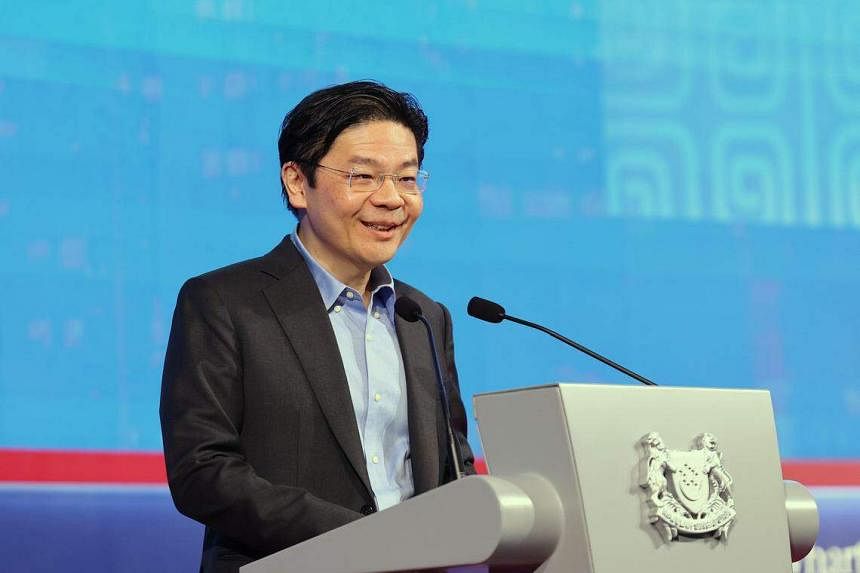
DPM Lawrence Wong said what happens over the next few decades will be defined by how the great power rivalry between both countries unfolds. PHOTO: LIANHE ZAOBAO

Natasha Ann Zachariah
Correspondent
Mar 12, 2023
SINGAPORE - In an increasingly polarised world, the need for multilateral frameworks that enable countries to do business with each other, even if they do not always see eye to eye, is stronger than ever, said Deputy Prime Minister Lawrence Wong.
“If we can forge stronger partnerships between the major powers and all countries in the region, we can help foster a more stable and prosperous Asia,” he stressed in a keynote speech at the 55th Wharton Global Forum on Saturday, calling for new working arrangements and international collaboration to tackle issues that affect everyone, such as climate change and future pandemics.
“We must all work together to fortify multilateralism, and the global rules of the game.”
What happens over the next few decades will be defined by how the rivalry between China and the US unfolds, said Mr Wong, describing Taiwan as a dangerous flashpoint, with the Ukraine war adding to tensions.
Speaking to 800 alumni of Wharton School of the University of Pennsylvania, business leaders and government officials at the Shangri-La Singapore, he noted that on the economic side, “the era of untrammelled globalisation we enjoyed over the last 30 years is over”.
More and more multinationals are looking to move production back home or relocate to markets that have a bigger consumer base, where they are less likely to get caught in geostrategic crossfires.
“Governments are also embracing more muscular industrial policies. The US, China and European Union are stumping out more aggressive support, in the form of tax breaks and subsidies, to develop domestic strengths in what they assess to be critical industries like semiconductors and green energy. We are seeing the emergence of an industrial policy arms race, and a huge contest for leadership in key technologies, which is likely to escalate with time,” said Mr Wong, who is also Singapore’s Finance Minister.
“Left unchecked, if this trend continues, we will see a more fragmented and dangerous global order.”
While the leaders of both the US and China have affirmed their intent to engage one another and said they do not want a new Cold War, more needs to be done, said Mr Wong, highlighting Singapore’s support for multilateral pacts such as the Regional Comprehensive Economic Partnership, the world’s largest free trade agreement, covering countries such as China, Japan, Australia and the 10 Asean nations.
“Meanwhile, the US has signalled its continued commitment to deepen its economic engagement of the region through the Indo-Pacific Economic Framework. Singapore has welcomed this too and hopes to work with partners to develop a framework which is open, inclusive, and flexible.”
Mr Wong highlighted how an open, rules-based international order helped keep the world relatively stable.
While such an order was never perfect, he said “this stability fostered international cooperation and gave birth to an era of unparalleled economic transformation – many countries prospered, and millions were lifted out of poverty”.
“Today the world is more divided than ever before. But amidst these differences, we must find enough common ground to solve our collective problems.”
He added that multilateral institutions, like the World Bank, World Trade Organisation and World Health Organisation, which have helped define the rules-based international order over the decades, “remain strong and relevant”.
Mr Wong said Singapore would do its part to advance these goals, while being realistic. “After all, we are really one of the smallest countries in Asia. We know that we have to adapt to the world as it is, not what we would like it to be.”
If not, he cautioned, Singapore might go the way of another Singapore – an American village founded in the 1830s in Michigan. Once a thriving lumber port town hoping to emulate the Asian city it was named after, it is now a ghost town after the lumber trade went into decline.
Mr Wong, who is an alumnus of the University of Michigan, said Singapore is determined not to meet the same fate. “Singapore today may be in a stronger position than when we started out... but we will always be that little red dot in the world. And in this era of change, really, one can never take things for granted.”
To thrive and prosper, Singapore will do its best to stay relevant and add value in the global network as a key node for trade, finance, talent and ideas. “We will continue to build a vast network of friends to promote peace and stability in our region, and, most of all, to preserve our sovereignty and right to determine our own future.”
Honesty.For goodness sake, PRC don’t need Sinkiestan in any way anymore. Think about it.
They can speak better English than any ah beng on our streets, Xi Dada stamped out corruption as much as he could in the last decade or so.
Land, they have. People, they have. Friends, they have. What do they lack?

America’s dilemma: How to meet the China challenge without scaring S-E Asian countries
Top US admiral’s recent ‘3 noes’ remarks reflect the inherent tensions.

James Crabtree
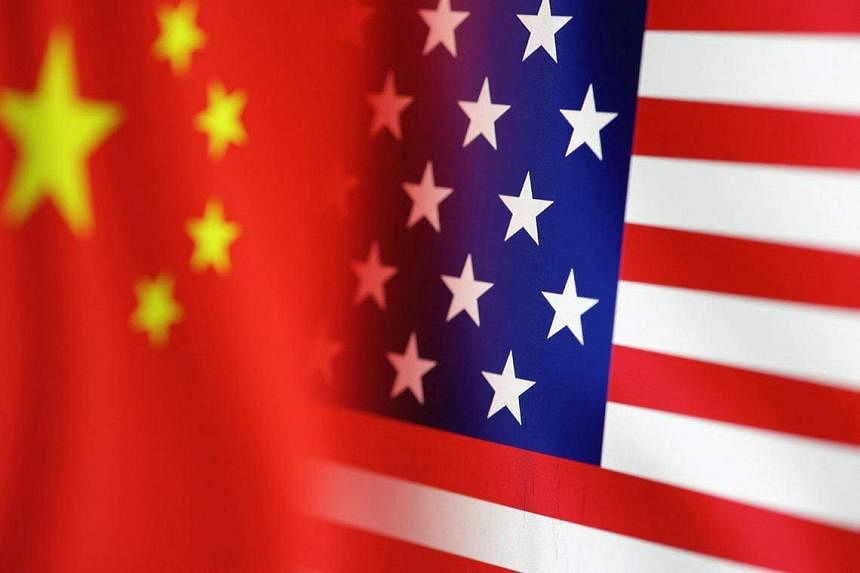
The US has, of late, been trying to push back against China’s rising power. PHOTO: REUTERS
MAR 21, 2023
Admiral John Aquilino, commander of the US Indo-Pacific Command (Indopacom), arrived in Singapore last week on a mission. The US has, of late, been trying to push back against China’s rising power. But its actions mean many in the region worry that it is Washington, rather than Beijing, that may be becoming the more provocative of the two regional superpowers.
Adm Aquilino seemed to note this, and began his speech last Thursday by reassuring his audience: “First and foremost: the United States does not seek conflict.” That statement is likely to be welcome. But will it be believed? And why was it necessary to make it in the first place?
These two questions contain within them deeper challenges for US strategy. To take one example, President Joe Biden in March launched the next stage of the Aukus security pact with Australia and Britain to supply nuclear-powered submarines to Australia.
Viewed from Washington, actions of this kind are needed to fashion a new regional balance of power. But they are also just the kind of actions that risk making it appear that Washington is responsible for rising regional temperatures.
Adm Aquilino is an intriguing figure to deliver these messages of reassurance. Based in Hawaii, he leads Indopacom, a giant military operation responsible for an area that ranges from the Indian Ocean to the US west coast.
Running a US “combatant command” – there are some 375,000 military and civilian personnel in the region Indopacom covers – means a core focus on war-fighting. If China and the US do go to war, Adm Aquilino is the person most responsible for ensuring the US prevails.
But he is also a senior diplomat able to meet prime ministers and presidents. “US combatant commanders are the modern-day equivalent of the Roman Empire’s proconsuls – well-funded, semi-autonomous, unconventional centres of US foreign policy”, as The Washington Post once put it.
The 3 Noes
That being said, the three-point salvo with which Adm Aquilino began his lecture at the International Institute for Strategic Studies (IISS) last Thursday is worth repeating.The US does not seek conflict, he began. “Nor do we seek to contain China. As stated in US strategy, we are engaged in a robust competition”, he went on. And the US “has not changed our policies towards Taiwan, and we do not support Taiwan independence”.
On the first point, the US might not seek conflict, but the tone of its domestic debate over China has undeniably grown more pugilistic. I spent a week in Washington in February and was struck by common discussion of scenarios involving conflict with Beijing.
The US has also of late rolled out prominent new anti-China measures, from Aukus to its policies stopping Chinese access to advanced semiconductors. More are likely in the coming months too, including measures stopping US companies from investing in Chinese technology businesses.
China certainly claims the US is bent on conflict. “If the US side does not hit the brakes but continues to speed down the wrong path, no amount of guard rails can prevent derailing or a crash and there will be conflict and confrontation”, as Foreign Minister Qin Gang put it on March 7.
The US disputes this, saying its measures are merely a response to China’s increasingly assertive actions. “The rules-based international order is under direct assault by authoritarian regimes”, as Adm Aquilino put it in his lecture.
On this account, it is Beijing that uses coercive actions with respect to Taiwan, not Washington. It was China which, to take just one recent example, used a military-grade laser to target Philippine ships in the South China Sea in February, prompting Manila to lodge a diplomatic protest.
Adm Aquilino’s second point of reassurance suggested the US does not seek to “contain” China. This responds to claims by China’s President Xi Jinping in March that “Western countries led by the United States have implemented all-around containment, encirclement and suppression of China, which has brought unprecedented severe challenges to our country’s development”.
US diplomat George Kennan introduced the idea of containment in the Cold War, recommending a “long-term, patient but firm and vigilant containment of Russian expansive tendencies”.
US policy towards China today is not an exact copy of this. Indeed, the idea of containing China makes little sense, given its economy is so closely intertwined with the rest of the world, in a way that was never true of the Soviet Union. That said, in the technological domain, the US is now following a roughly analogous policy, seeking to stop China’s access to advanced technology from semiconductors to AI.
Taken together, what might be styled as Adm Aquilino’s “three noes” were designed in part to reassure Beijing. But they were also aimed at anxious audiences in Singapore, Kuala Lumpur, Jakarta and elsewhere.
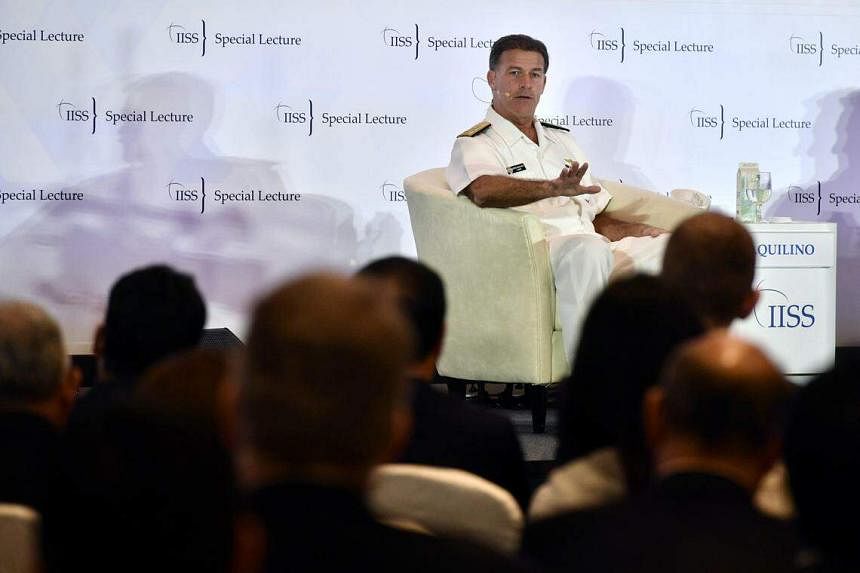
Admiral John C. Aquilino, Commander of the United States Indo-Pacific Command, speaking on the subject of Managing Strategic Competition and the Quest for an Enduring Future in the Indo-Pacific at the Shangri-La Hotel on March 16, 2023. ST PHOTO: DESMOND FOO
Here the US faces a complex calculation. In private, its balancing actions tend to be supported by local security elites. Few in South-east Asia look forward to a future of Chinese regional hegemony. Most therefore want the US to continue to play a balancing role, alongside Australia, Japan, India and others.
That said, regional leaders are also anxious about Washington’s deteriorating ties with Beijing. The Chinese response to then Speaker Nancy Pelosi’s visit to Taiwan last August was one low point. The recent contretemps over Chinese surveillance balloons hardly inspired confidence either.
Two different challenges
This leaves the US with two different challenges, the first of which involves managing the regional reaction to their initiatives to re-establish deterrence. Here Aukus again provided an interesting example.In public, Malaysia and Indonesia have long expressed concerns about the deal, citing worries over nuclear proliferation. In private, Kuala Lumpur and Jakarta are often more relaxed. But last week, Malaysia still put out a statement urging “all parties to avoid any provocation and arms competition in the region”.
There is something of a double standard here. Australia’s plans will produce up to eight nuclear-powered submarines. But China already has six ballistic-missile submarines, six nuclear-powered attack submarines and 46 diesel attack submarines, according to IISS data. Neither Malaysia nor anyone else asked China to avoid “arms competition” as it built up this force.
The second US challenge is to ask whether it is doing enough to balance China in the first place? Here, the picture is mixed.
Measures like Aukus give a sense of energy. The US is building deeper partnerships with allies like Japan and India. Its ties with the Philippines have been notably positive too, with President Ferdinand “Bongbong” Marcos surprising many senior officials in Washington with his willingness to cooperate.
Progress has been slower in other areas, however. President Biden in March unveiled the largest US peacetime defence budget request in history, asking for US$886 billion (S$1.2 trillion). Yet even this vast sum will quickly get gobbled up by priorities from Ukraine to long-term research and development. Over at Indopacom, Adm Aquilino will inevitably get less than he would like.
Indeed, Indopacom’s shopping list is lengthy. It wants funds to bulk up defences at its base in Guam, a tiny US island territory in Micronesia. It aims to build new facilities distributed around the Pacific too. Then it wants new weapons, notably long-range missiles, as well as deeper stockpiles. And all of this when a creaking US industrial base is struggling to produce weapons to supply Ukraine, let alone any future scenarios in the Indo-Pacific.
However they move forward with these priorities, the US and its partners must ultimately take two contradictory steps at once. First, they must continue to take bold steps to increase deterrence and fashion a new balance of power in the Indo-Pacific. But second, they must also do this in a way that is not seen to be excessively provocative, and which reassures non-aligned nations in South-east Asia and elsewhere.
Many in South-east Asia hope for a period of de-escalation. Implicitly, this puts the ball in Washington’s court, and asks what President Biden and his team might do to cool temperatures. Less attention is paid to the kind of measures China might also contribute to build confidence and dialogue. But given Beijing and Washington are both preparing measures to compete with each other, unilateral or mutual de-escalation sadly does not look terribly likely.
What might the US do instead? First, it can keep offering reassurance about its intentions, as Adm Aquilino did with his “three noes” last week. Second, it can put extra effort into communication, as it did in trying to address regional concerns prior to the recent Aukus announcement. And third, it can try to build stronger ties with the South-east Asian countries themselves, in order to build trust and mutual understanding.
Ultimately, however, this balance of action and reassurance presents a tension for US strategy. Tensions between China and the US are not occurring because of a short-term breakdown in communication, but for far more fundamental reasons.
As the Chinese proverb puts it: “One mountain cannot contain two tigers.” Those watching anxiously in South-east Asia must keep hoping their region’s two tigers can come to live with each other after all.
- James Crabtree is executive director of the Asia office of the International Institute for Strategic Studies.
US-China ties: Averting the grandest collision of all
The Song-Liao treaty from Chinese history offers lessons on how fierce rivals can avoid war
Graham Allison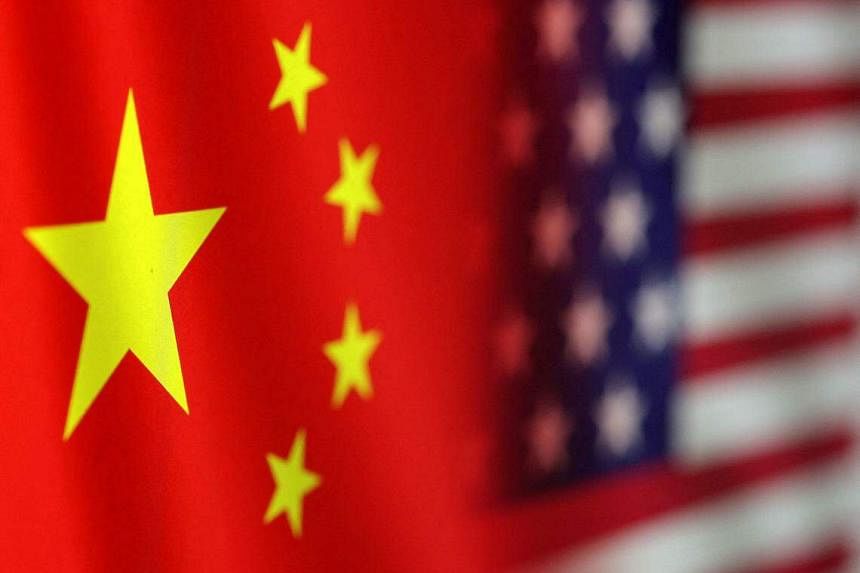
Leaders in both Washington and Beijing will have to find a way to cooperate in some areas while competing ruthlessly in others. PHOTO: REUTERS
MAR 20, 2023
If historian Thucydides were asked about what is happening in relations between the United States and China today, what would he say? That was the question posed to me at the Davos World Economic Forum in January. I responded that he would say that this is a classic Thucydidean rivalry in which the two parties are right on script, each competing to show which can best exemplify the typical rising and ruling power – leaving him on the edge of his seat anticipating the grandest collision of all time.
The debate that began in 2017 with the publication of Destined For War: Can America And China Escape Thucydides’s Trap? is now in the rear-view mirror. No one can deny that China is the most formidable rival a ruling power has ever seen.
Over the past generation, China has risen further and faster along more dimensions than any nation in history. During President Xi Jinping’s first decade in power, China’s gross domestic product has risen from half to three-quarters the size of the US economy (measured in market exchange rate). China has displaced the US as the world’s No. 1 manufacturer, No. 1 trading partner, and become a source of the most critical items in global supply chains.
It has also strengthened its military capabilities, with a specific focus on contingencies along its border and peripheral seas, to the point that it now has significant advantages in potential conflicts, particularly Taiwan contingencies.
Meanwhile, what Winston Churchill called the “deadly currents” in domestic politics that drove Britain to war with Germany in 1914 are now running rife in the US.
As anyone who watched the opening hearings of the newly established House Select Committee on China saw vividly, Republican and Democratic politicians are rushing to show who can be tougher on China.
Presidential hopeful Mike Pompeo has already called for the US to recognise Taiwan as an independent country. The bipartisan Taiwan Policy Act – co-sponsored by Democratic Senate Foreign Relations Committee chairman Bob Menendez and Republican Lindsey Graham – initially proposed to designate Taiwan a “major non-Nato ally”. It is instructive to note that it was Taiwanese President Tsai Ing-wen, not US House Speaker Kevin McCarthy, who appreciated the likely consequences of another visit to Taiwan by the Speaker of the House and proposed a less provocative alternative.
We see similar rumblings in Beijing, where Mr Xi accused the US and its allies of pursuing the “containment, encirclement, and suppression” of China in a fiery speech in March at China’s Two Sessions, the annual meetings of China’s top political advisory body and legislature, collectively known as lianghui. Mr Xi’s comments were echoed by new Foreign Minister Qin Gang, who said “hysterical neo-McCarthyist” politicians in the US wanted to cripple China in a “zero-sum game” of life and death.
Fortunately, in US President Joe Biden and Mr Xi we have two serious, sane leaders who recognise that war between their nations would be catastrophic. If a local war over Taiwan escalated to a full-spectrum war with nuclear attacks upon each other, it would risk the survival of both their nations.
However extreme the differences between the two rivals, if the alternative to co-existence really is to co-destruct, rational leaders in both Washington and Beijing will have to find a way to cooperate in some areas while competing ruthlessly in others.
‘Rivalry partners’
As thinkers in both governments are struggling to find a framework to do this, there are lessons to learn from the ancient Chinese concept of “rivalry partners”.Rivalry partners sounds like a contradiction. But it describes the relationship the Song Dynasty established with the neighbouring Liao, a Manchurian kingdom on China’s northern border, a millennium ago. Concluding that his armies would not be able to defeat the Liao in military conflict, the Song Emperor negotiated the Chanyuan Treaty of 1005 in which both sides agreed to be fierce rivals in some arenas but great partners in others.
This unique arrangement saw the Song – the ruling power – pay tribute to the Liao, who agreed to invest that payment in the Song’s economic, scientific, and technological development. The framework established by the Chanyuan Treaty averted war between the two powers for over a century.
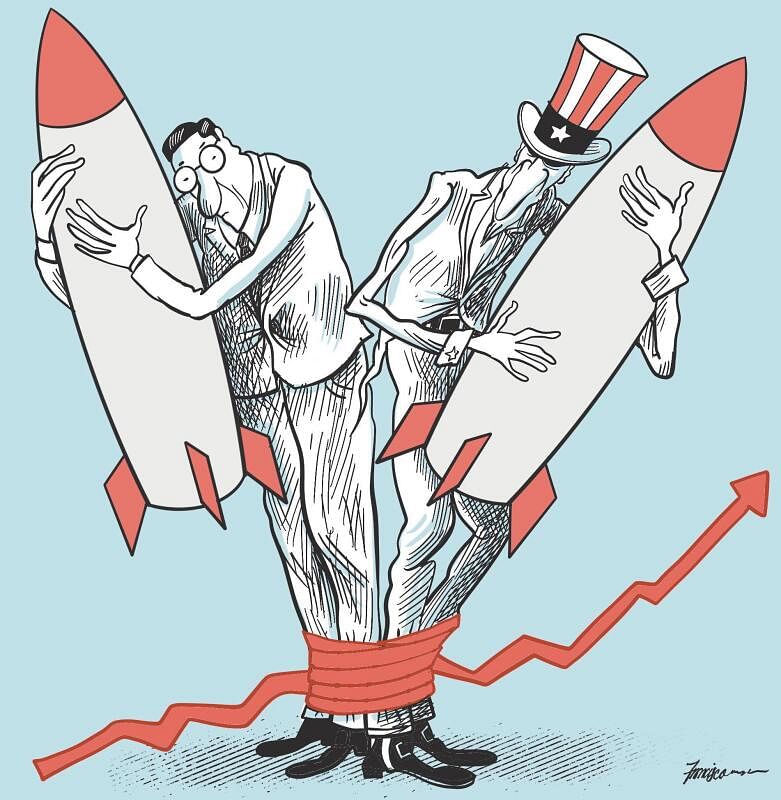
ST ILLUSTRATION: MANNY FRANCISCO
US and China should return to diplomacy to mend ties: Former US ambassador to China
‘Catastrophic consequences’ if US keeps current course, says Beijing
Conceptually, the Song-Liao rivalry partnership drew on even older Chinese wisdom from the Spring and Autumn period. As Sun Tzu wrote of the rival Wu and Yue kingdoms in The Art Of War, “the people of Wu and Yue were mutual enemies, but when they sailed on the same boat and encountered a storm, they helped each other like left and right hands”. Where survival requires cooperation, even the deadliest of enemies can rise to the occasion.
What would a rivalry partnership in US-China relations today look like?
The starting point would be recognition of the fundamental structural realities both nations face today. In a phrase, they must survive in a MAD world.
Both the US and China now have nuclear arsenals that are capable of withstanding a first strike from the other and retaliating with an attack that destroys the attacker. Thus, as certainly as it did in the most dangerous days of the Cold War between the US and Soviet Union, then President Ronald Reagan’s insistence that “a nuclear war cannot be won and therefore must never be fought” remains a foundational truth in relations between the US and China.
Recognising this nuclear risk and the ways in which Russia’s President Vladimir Putin’s threats to conduct tactical nuclear strikes against Ukraine would violate the “nuclear taboo” that has emerged over the past seven decades, in November, Mr Xi and German Chancellor Olaf Scholz took a major step forward. They declared unambiguously that they opposed even the threat to use nuclear weapons.
As China’s Ministry of Foreign Affairs noted, Mr Xi declared that the international community should “oppose the threat or use of nuclear weapons, advocate that nuclear weapons cannot be used and that nuclear wars must not be fought, and prevent a nuclear crisis in Eurasia”.
The Xi-Scholz “no nuclear threat” doctrine takes a bold step beyond any previous statement of any major government. China, for example, has a “no first use” policy but has never said “no threat of use”, and though Mr Scholz did not comment on it, Germany’s national security depends on US “extended deterrence” that leverages the threat of nuclear first use to defend its treaty allies.
The Xi-Scholz doctrine is a vivid demonstration that however sharp the differences between China and the US, on the issue of preventing Mr Putin from conducting nuclear strikes and averting the proliferation incentives such a decision would create, China can act to advance an interest the rivals share.
As inhabitants of the same enclosed biosphere, the Americans and Chinese also face an analogue of mutually assured destruction in unrestrained greenhouse gas emissions. China is the world’s No. 1 greenhouse gas emitter; the US is No. 2. On their current trajectories, either country can by itself so disrupt the climate that neither of them can live in it.
In the current globalised world, we also have a thickly integrated financial system that is subject to crises, such as the Great Recession of 2008, that could cause another Great Depression. In 2008, we narrowly escaped that – but only by a carefully coordinated joint stimuli by the US and China.
Beyond these shared interests there are pandemics, mega-terrorism, the proliferation of nuclear weapons, and other global challenges that neither can manage by itself. And finally, there are the irresistible benefits of global integration, particularly in the economic arena that bring with them MAED (mutual assured economic disruption).
Zero-sum contest
Of course, some arenas will be marked by fierce rivalry. The military arena is mostly zero-sum, where “every domain is contested”, as former US secretary of defence James Mattis put it starkly in his 2018 National Defence Strategy. Since the two rivals will also be competing for economic and technological dominance, selective decoupling is inevitable.In sum, the US and China are locked in conditions defined by two contradictory imperatives: to compete in the greatest rivalry of all time, and to cooperate for each to ensure its own survival.
For each, creating a grand strategy that combines competition and cooperation will require extraordinary strategic imagination. As policymakers in both nations are wrestling with this assignment, clues from the “rivalry partnership” that gave the Song and Liao 120 years without war can be instructive.
- Graham Allison is the Douglas Dillon Professor of Government at the John F. Kennedy School of Government at Harvard University.
- This article was first published on the website of the Asian Peace Programme, an initiative to promote peace in Asia housed in the Asia Research Institute, National University of Singapore.
Singapore’s response to China’s influence in Asean critical to regional peace: Historian Wang Gungwu
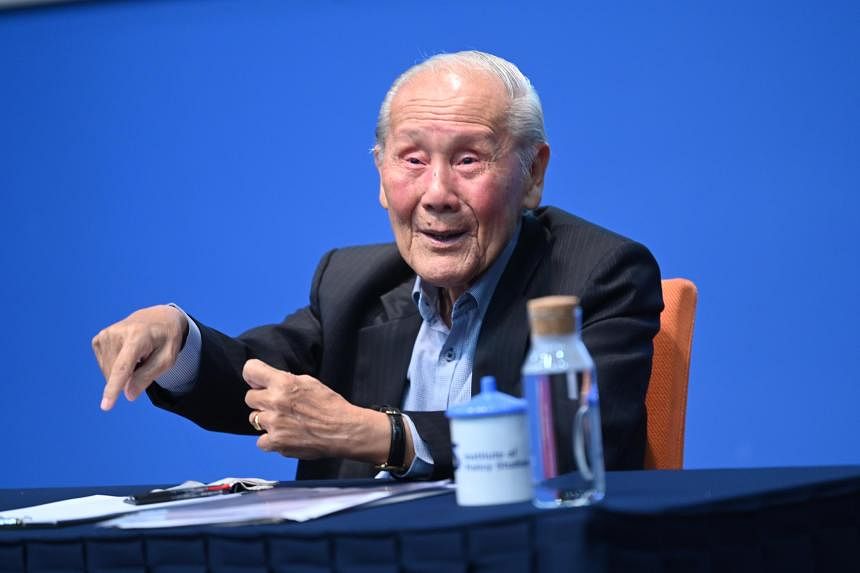
Prof Wang Gungwu speaking at the Institute of Policy Studies’ IPS-Nathan lecture series, “Living With Civilisations: Reflections On South-east Asia’s Local And National Cultures”, on March 8 at NUS. PHOTO: INSTITUTE OF POLICY STUDIES/JACKY HO

Chin Soo Fang
Senior Correspondent
MAR 9, 2023
SINGAPORE – Singapore is committed to the idea that its citizens, of whatever origin, should respond only to borderless civilisational appeals and not to nationalist ones, said Professor Wang Gungwu.
Speaking on the topic of China’s influence in Asean and how Singapore should position itself, the eminent historian said Singapore’s modern culture would require its leaders to try their hardest to keep the national and the civilisational clearly differentiated.
It is also in the Republic’s interest to support the common aspirations of all member states of the region, he added.
“Its most important contribution is to ensure that Singaporeans of Chinese origin would be able to act in ways that the whole Asean community can understand and be comfortable with,” Prof Wang said. “That would show how a modern nation-state could, as with cultures in the past, co-exist with a variety of living civilisations.”
Prof Wang was speaking at the Institute of Policy Studies’ IPS-Nathan series, “Living With Civilisations: Reflections On South-east Asia’s Local And National Cultures”, on Wednesday at the National University of Singapore (NUS). The 93-year-old has been University Professor at NUS since 2007, and Emeritus Professor at the Australian National University since 1988. He was also director of NUS’ East Asian Institute from 1997 to 2007.
Nobody foresaw the swift rise of China and its turn towards a state-centred capitalism that provided it with the economic power to make it appear as a threat to the United States, Prof Wang said.
He added that China’s success in using the developed world’s free market economy to reach out to the developing world has made its modern claims more credible than anyone thought were possible.
Equally surprising has been the American response. The politically polarised nation has called for an aggressive nationalism against China, a call that seems to have been the only one that can unite the country, Prof Wang said.
In response, China has revived the nationalism that had enabled its people to resist Japanese invasions a century earlier, he said.
“What is new is that both the PRC (People’s Republic of China) and the US now see themselves as representatives of progressive civilisations,” he said. “I cannot predict the outcome of that dangerous rivalry.”
Elaborating on the history of Asean, he said that at the end of the Cold War, all 10 states came together as an enlarged Asean and learnt to deal with the globalised world as a regional association.
However, their ties with other civilisations are retained largely through their mix of peoples, who remain proud of their respective civilisations and help to keep their plural societies alive.
Where Singapore in South-east Asia is concerned, he said: “I am one of many who have been concerned as to what those of Chinese origins might do when the PRC calls on them as Chinese to sympathise with its aspirations for the future. Needless to say, there will also be repercussions in other Asean states.”
Besides Singapore, no other state has a majority whose populace might be expected to provide a singular response to this inescapable dilemma, he added. All Asean member states will closely observe how Singapore resolves this conundrum.
“If Singapore can... show how that response conforms to South-east Asian experiences, it should strengthen the region’s confidence in responding to its relations with other civilisations,” he said.
On the region, Prof Wang added: ”If it can hold firm as a united Asean that co-exists with living civilisations, that might help to prevent our peace-seeking multi-civilisational world from descending into the warring nationalist cultures that threaten all of us today.”
US, China need to dial down tensions and work together on global challenges: Tharman
1 of 3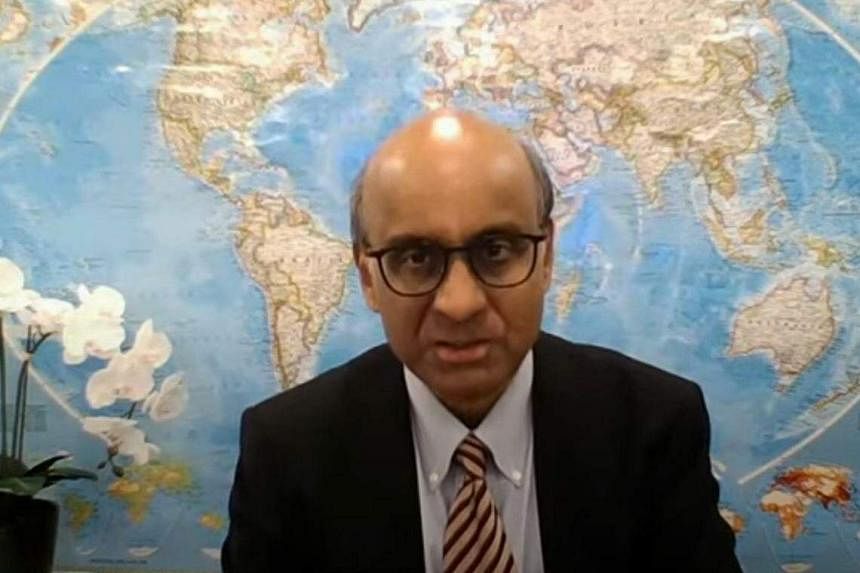
Senior Minister Tharman Shanmugaratnam, speaking virtually during the Semafor World Economy Summit in Washington, DC, US.

Charissa Yong
US Correspondent
Apr 13, 2023
WASHINGTON - The United States and China should prioritise dialling down the temperature to prevent their relationship from worsening further, said Singapore’s Senior Minister Tharman Shanmugaratnam on Wednesday.
Doing so would help the two superpowers work together to tackle challenges facing the earth’s shared natural resources such as climate change, the global water crisis and the loss of biodiversity, he told bankers, finance chiefs and business leaders at a forum in Washington.
“We’re not going to solve any of the problems of global commons, climate change being foremost, without both the US and China playing a bold and forward-looking role,” he said at the inaugural World Economy Summit, organised by news website Semafor.
“I think there’s a willingness on the part of both, but it requires an overarching framework that allows for both competition and collaboration, and that builds trust. What is lacking today is trust.”
Mr Tharman also said that international financial institutions like the World Bank and International Monetary Fund can help ease polarisation in the global order by bringing the US and China together to work on joint projects.
“The fundamental problem that we have is that we are not collectively making enough use of these international institutions,” he said.
“How do we use this collective project, how do we maximise the use of the international financial institutions to tackle the problems of the global commons… to reduce the polarisation in the system and to create projects of common interest to the US and China in particular?”
Mr Tharman, who is also Coordinating Minister for Social Policies, is on a working visit to Washington until Saturday to attend meetings of the International Monetary and Financial Committee.
He will also attend meetings of other international organisations, including a Group of 20 expert group on strengthening multilateral development banks, as well as meet senior officials from the US and other countries.
The importance of the US and China finding a way to collaborate while competing, and the necessity of collective action in tackling global problems such as climate change, have been key themes in Mr Tharman’s recent speeches, including the one he delivered in March at the China Development Forum in Beijing.
On Wednesday, he made the case that governments need to make their economies more resilient, given that the world is increasingly punctuated by major shocks like the Covid-19 pandemic.
To do so, they should first improve their own finances and build up resources in the good times, he said.
“That’s the first point – we must have a conservative bent in normal times, so we build up resources knowing that we’re going to need them when times go bad,” he said.
But international institutions and multilateral development banks (MDBs) should also work with countries to address long-term global challenges, Mr Tharman said.
“If we leave it to countries to fend for themselves, they will only do what is necessary for their own immediate benefit,” he said.
“This requires collective investment by the MDBs, together with national governments, so that we don’t have a trade-off between national development priorities within a short or medium-term timeframe, and doing our part to support the longer-term global public good.”
US and China ‘not in Cold War’, reality is more complex: Experts at Singapore forum
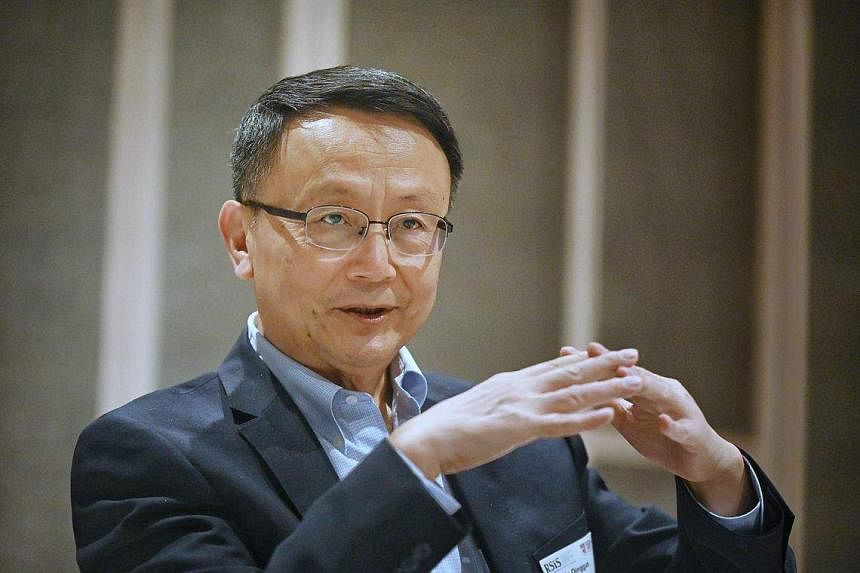
Professor Jia Qingguo from the Peking University said that while the US and China are not in a state of Cold War, they are moving towards that direction. ST PHOTO: DESMOND WEE
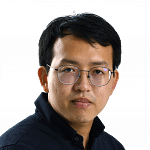
Lim Min Zhang
Assistant News Editor
Apr 23, 2023
SINGAPORE – Senior academics from the United States and China held a forum in Singapore on Friday, with ways to stabilise the Sino-US relationship among the top issues on the agenda amid worsening ties in recent years.
Speaking to reporters on the sidelines of the event, one of the participants, international relations scholar Jia Qingguo from Peking University said that while both countries are not in a Cold War, they are moving in that direction.
Two dangerous trends are emerging, he added. One is thinking of everything in terms of security.
“For example, the US is now coming up with a list of so-called entities, and policy after policy of delinking the technological relationship in the name of national security,” he said.
The US includes more than 600 Chinese establishments on the Entity List, which blocks them from buying technology from American suppliers unless they have government authorisation.
The other, said Professor Jia, is seeing both sides as ideological foes when this is not the case. In his view, they share common values such as equality, democracy and freedom.
But once the ideological differences are emphasised, the relationship becomes a contention between identity politics – and this would mean there is very little room for compromise, pragmatic solutions or management of the relationship, he said.
An example of emphasis on ideological differences was when US President Joe Biden, in his State of the Union address in 2022, referred to the Ukraine war as “a battle between democracy and autocracies”, although he made no mention of China in that part of the speech.Fellow participant Jude Blanchette, who holds the Freeman Chair in China Studies at the Washington-based Centre for Strategic and International Studies (CSIS), believes the reality is more complicated than what can be captured by the concept of a Cold War.
“I think the great challenge for us is to find a better framework to describe the relationship,” he said in a separate interview at the Parkroyal Collection Marina Bay hotel, where the one-day exchange was held.
This would be a framework with the “undeniable elements of rivalry” between two global powers with significant military capabilities that are rubbing up against each other in a number of domains, but are also inextricably linked economically and technologically.
The trilateral exchange involved 120 participants, including scholars from the CSIS think-tank and Peking University’s Institute for Global Cooperation and Understanding. It was organised by the S. Rajaratnam School of International Studies (RSIS).
The discussion, titled US-China Relations: The Future Of International Order, also involved topics such as the implications of US-China competition, how to promote cooperation and the role of other countries, such as those in South-east Asia.
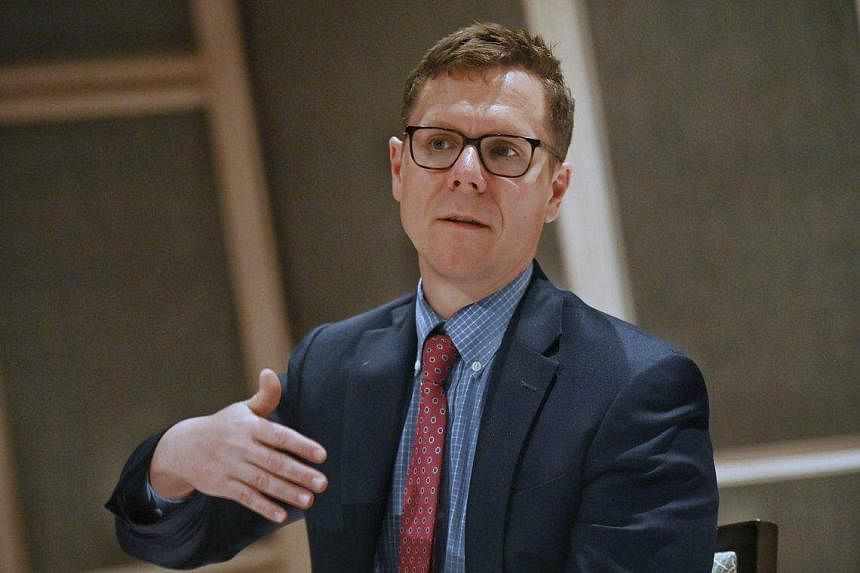
Mr Jude Blanchette of the Centre for Strategic and International Studies in Washington believes the reality of the Sino-US relationship is more complicated than what can be captured by the concept of a Cold War. ST PHOTO: DESMOND WEE
Mr Blanchette described the US-China relationship as being in a state of transition.
The US remains a powerful actor in the international system, but is no longer as influential as it was in the 1990s.
But a much more confident, assertive and powerful Beijing – which the US has to adjust to – is still learning to navigate the geopolitical environment, which he described as “building the plane as it is flying”.
Mr Christopher Johnstone, senior adviser and Japan chair at CSIS, noted at the forum that every major alliance that the US has in the Indo-Pacific region has been growing recently, citing the examples of Japan, South Korea and the Philippines.
This is not because the US has engaged in “brilliant diplomacy”, he said. “It is happening because all those partners are deeply concerned about their security environment, and by China’s behaviour.”
On what can be done, Prof Jia said guard rails are needed, not just to prevent an accidental military conflict between the US and China, but in their political relationship too.
“The US Congress is not supposed to poke into the eyes of the Chinese all the time. How to restrain their behaviour – that is a big challenge for both countries,” said Prof Jia, who is former dean of the School of International Studies at Peking University.
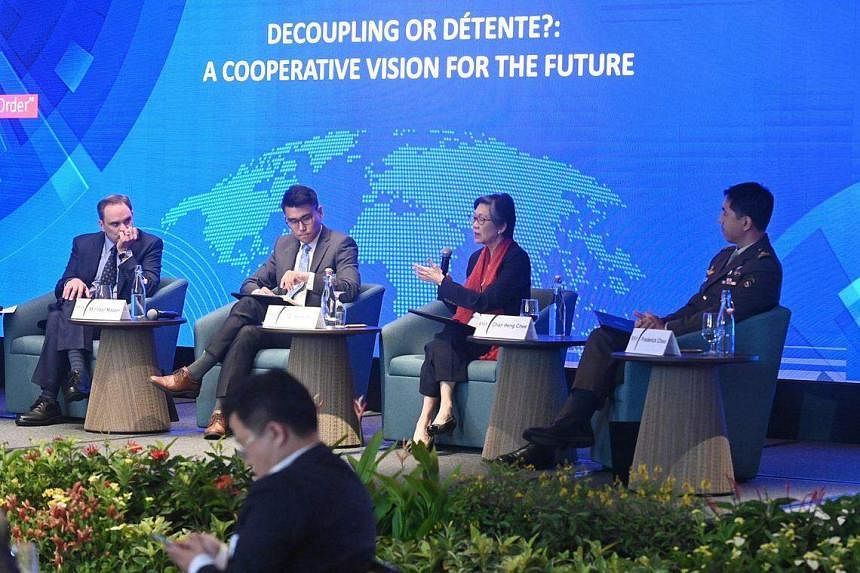
Panellists (from left) Michael Mazarr, Qi Haotian, Chan Heng Chee and Frederick Choo speaking during a discussion at the 4th Trilateral Exchange organised by the S. Rajaratnam School of International Studies. ST PHOTO: DESMOND WEE
Participants at the forum also included Singapore government officials and representatives from RSIS.
The Ministry of Defence’s deputy secretary for policy, Brigadier-General Kelvin Fan, believes that while competition between the US and China is likely to increase, there are many ways to prevent it from escalating into military conflict. Crucially, he said, communication between both sides is lacking.
“What we need to do is not just more communication, but also better-quality communication underpinned by trust and strategic empathy.”
RSIS executive deputy chairman Ong Keng Yong said the face-to-face interactions at the exchange between scholars from both sides is valuable.
“Even if you might be well aware of what the other side’s views are, to hear it from each other and then to allow the other side to rebut you, or to give you an answer as to why you have this wrongful perception, is important.”
Are South-east Asian states balancing against China?
Arms spending and defence partnerships with the US and its partners seem to point that way. But there are more factors in play.
Evan A. Laksmana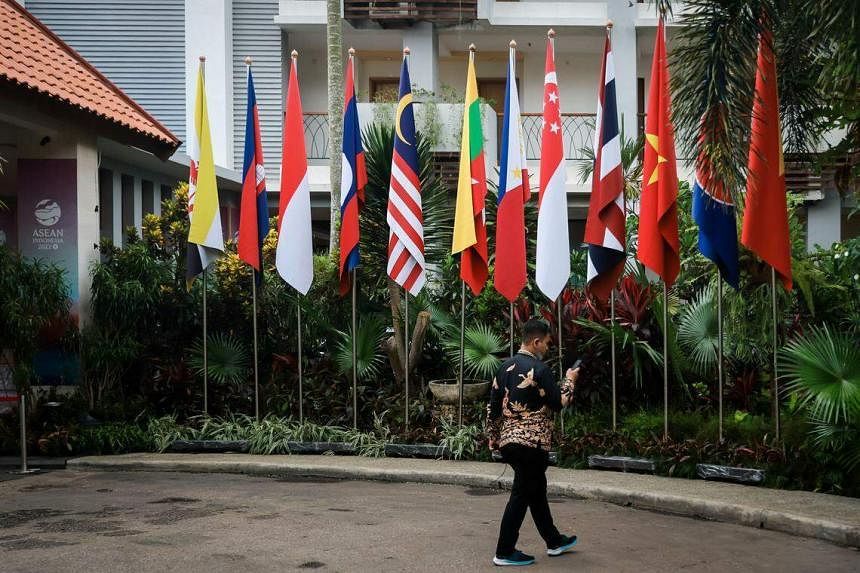
All South-east Asian countries have strong economic ties to China; many regional political and business leaders have looked to China. ST PHOTO: GAVIN FOO
May 30, 2023
Where do South-east Asian countries stand in the tug of war between the United States and China? It is a question that comes up time and again, given the region’s strategic importance in the unfolding great-power politics.
Indeed, any military conflict involving the two powers would critically affect all 10 member states of the Association of South-east Asian Nations (Asean). All South-east Asian countries have strong economic ties to China; many regional political and business leaders have looked to China for their post-Covid-19-pandemic recoveries.
On the other hand, key countries like Singapore, Indonesia, the Philippines, Thailand and Malaysia have all forged strong defence and security partnerships and alliances with the US. Any US-China military conflict could thus force the region into painful strategic choices it does not wish to make. This is not even including the challenge of securing the safety of nearly 700,000 migrant workers from Indonesia, the Philippines, Thailand and Vietnam in Taiwan.
Against this backdrop, we have also seen South-east Asian states bulking up their militaries. Indonesia, Malaysia, the Philippines, Singapore, Thailand and Vietnam have acquired next-generation fighters, frigates, submarines, anti-ship missiles and other complex platforms over the past decade or will seek to procure them in the next.
This group of six countries collectively spent more than US$57 billion (S$77 billion) on major arms acquisitions from 2012 to 2022, according to IISS Military Balance data. The group’s combined defence budget increased from about US$30 billion to more than US$44 billion in the same period (though the 2022 figures amount to only 1.35 per cent of GDP, on average).
Key South-east Asian states have also ramped up their defence engagement with the US. Indonesia launched the Super Garuda Shield military exercise in August 2022, effectively expanding what was originally a bilateral army exercise into the largest joint, multinational exercise in the Indo-Pacific involving 14 nations.
Thailand and the Philippines also hosted their largest military exercises with the US in March and April 2023. These are on top of the hundreds of annual engagement activities and the dozens of education and training exchanges involving thousands of South-east Asian security officials over the past decade.
An incomplete picture
These two trends – arms spending and stronger defence ties with the US –have led analysts to argue that South-east Asia is slowly but surely balancing against China. This view, however, is incomplete at best.First, as we shall see from June 2 to June 4 at the 20th IISS Shangri-La Dialogue, South-east Asian states will continue to seek a middle position between the US and China, hedging against the uncertainty inherent in their competition. Indonesia, the Philippines, Singapore, Thailand and Vietnam, to different degrees and in different styles, will likely express their continued concern about the rivalry and over the spread of geopolitical competition to the military, economic and technological domains.
Such polarisation and the ensuing calls for decoupling, or “de-risking”, according to the latest Group of Seven (G-7) communique, have not been warmly embraced by South-east Asia. As Deputy Prime Minister Lawrence Wong cautioned on May 25 at the Nikkei Forum: “If de-risking is taken too far, it would prompt reactions and unintended consequences. Over time, we will end up with a more fragmented and decoupled global economy.”
This is why we are likely to see regional policymakers asserting that they would like Beijing and Washington to reopen closed lines of communication as a start, and some may even be hoping for a complete strategic reset, unlikely though this may be. They nevertheless hope that both powers can work together on some areas in South-east Asia, including on regional economic integration, climate change and the energy transition.
These expectations come as the region struggles with slow post-pandemic economic recovery and the fallout from Russia’s war in Ukraine. While South-east Asian countries appreciate regional powers such as Australia and Japan stepping up their strategic engagement – and may eventually warm to new minilaterals such as Aukus and the Quad – they still prefer to use Asean as the primary format for regional engagement.
Indonesia, for one, has often leveraged Asean as a strategic buffer between competing great powers and currently holds the rotational chairmanship of the group. It plans to host an Indo-Pacific Forum on the sidelines of the East Asia Summit in early September and will use the meeting to try and give form and substance to the Asean Outlook on the Indo-Pacific, designed as a middle ground amid duelling Indo-Pacific strategies. Indonesia’s defence ministry has also taken the lead in drafting defence-specific principles and cooperative activities as part of this effort.
Second, no country in the region has overhauled the organisational, doctrinal and operational outlooks of its armed forces with the goal of deterring and fighting a war against China. Acquiring arms and equipment is fundamentally different from how ready you are to use them.
For one thing, many South-east Asian states are still confronting a multitude of security challenges on a daily basis, from natural disasters, countering transnational crime, terrorism and insurgencies to securing their claimed exclusive economic zones. China’s strategic designs for the region and its aggressive behaviour are not the only threat vector defence policymakers have to wrestle with.
For another thing, fiscal constraints and bureaucratic hurdles – including inter-service rivalries – have hamstrung ambitious attempts at military modernisation. China’s aggressive behaviour and the increasing prospect of a US-China conflict emerging have provided new rationales to South-east Asian states in advancing their pre-existing military procurement plans. Their need to strengthen domestic defence-industrial bases provides further support.
But a genuine balancing attempt against China would require South-east Asian states to genuinely transform their archaic defence institutions – from organisation and personnel to training, exercises and education, and strategic planning. Investing in hardware is certainly necessary to boost defence capabilities but will never be sufficient without the “software and brainware” as well.
Other priorities
Finally, South-east Asian states seek stronger defence partnerships with the US and its allies and partners to meet their security needs, not necessarily to strategically align themselves to one great power over another, as challenging as that may seem today.Indonesia, Thailand, Malaysia and the Philippines, for example, have long-term military modernisation plans and frameworks. Given their underdeveloped domestic defence industrial bases, stronger defence partnerships with key states in Europe, the US and even South Korea will be crucial to achieve those plans. This is particularly the case in the light of Russia’s invasion of Ukraine that throws its credibility as a defence supplier and partner into question.
The key partners are also in the position to provide access to high-quality training, education and exercise opportunities for South-east Asian armed forces. As emerging technologies – from cyber to artificial intelligence and beyond – play a critical role in defence capabilities, South-east Asian states will also need closer ties with those controlling their access.
More broadly, as much as the US and its allies would like to capitalise on the strategic momentum provided by the alignment of defence needs and partnerships, they should be cautious not to overplay their hand. Not only are concerns over great-power competition continuing to overshadow alignment choices, but many in South-east Asia are also still aware of the pitfalls of over-reliance and dependence on the West for their security and defence capabilities.
Defence partners seeking to engage South-east Asian defence industries and establishments should therefore be ready to meet their localisation and offset needs – from technology transfer to the development of joint ventures and even defence industrial estates, as Thailand has proposed. Indonesia has had a defence industrial law mandating these requirements, while the Philippines is considering a similar legal framework.
Overall, we are likely to see South-east Asian defence officials at the Shangri-La Dialogue emphasising the need for participating countries to improve collaboration on resolving a range of regional security challenges. This will include a call for Beijing and Washington to manage their competition in a way that avoids an all-out conflict, and for deeper defence partnerships with key countries, including South Korea, the US, and many in Europe.
For many states in the region, the real challenge will be in finding ways to strengthen these defence partnerships to address security needs and boost strategic autonomy without joining one side or the other in the polarising competition between China and the US.
- Dr Evan A. Laksmana is senior fellow for South-east Asia Military Modernisation at the Asia office of the International Institute of Strategic Studies (IISS) in Singapore. This article has been expanded from an online analysis for the IISS.
Sinkieland is nothing but just a bunch of monolingual Singlish speaking angmoh wannabe Sinkies. Still yaya papaya and think they are very important after arse fucked by Angmorika.For goodness sake, PRC don’t need Sinkiestan in any way anymore. Think about it.
They can speak better English than any ah beng on our streets, Xi Dada stamped out corruption as much as he could in the last decade or so.
Land, they have. People, they have. Friends, they have. What do they lack?
Lianhe Zaobao strongly refutes ‘biased comments and unfair statements’ in Washington Post article
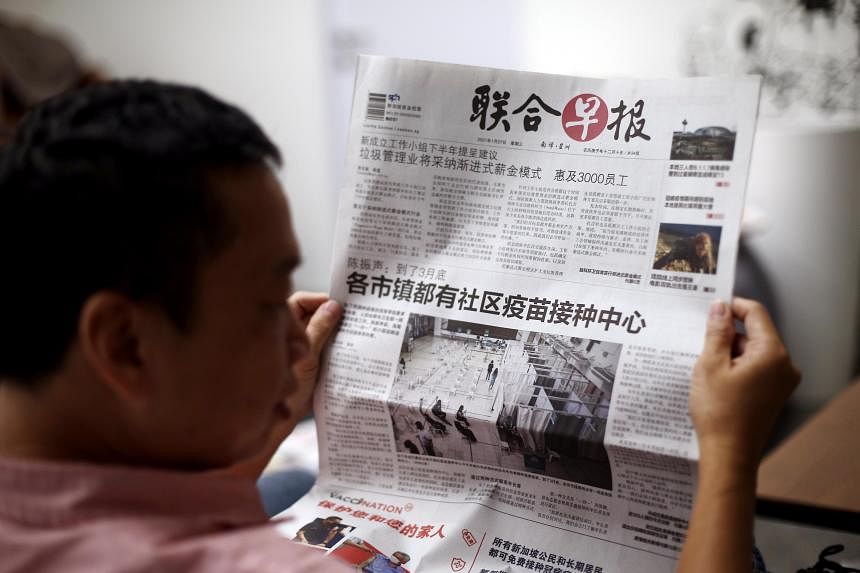
Lianhe Zaobao editor Goh Sin Teck said the Washington Post had selectively left out facts while intentionally highlighting others to paint a negative image of Zaobao. PHOTO: LIANHE ZAOBAO
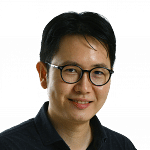
Lim Yan Liang
Assistant News Editor
August 5, 2023
SINGAPORE - Chinese language media Lianhe Zaobao has stressed that it takes its mission of delivering information seriously and remains committed to neutrality.
The comments by Zaobao’s editor Goh Sin Teck came a day after the Washington Post put up its story “In Singapore, loud echoes of Beijing’s positions generate anxiety” on July 24. Mr Goh said the American newspaper had looked at the issue with its own pre-established perspective and agenda. It selectively left out some facts while intentionally highlighting others to paint a negative image of Zaobao, he said, “which is regrettable but not surprising to us”.
“We had earlier provided comprehensive responses to the questions raised by the Washington Post, which were not adequately reflected in their reporting,” he added.
This is what Zaobao had told the Washington Post:
On columnists: How are they picked and are they paid? The Post had also asked for confirmation that two regular columnists, Ding Song Quan and Deng Qingbo, are both Communist Party officials and asked why they are described as China affairs commentators.
Zaobao’s official position is only carried in its editorials. We aim to feature a broad spectrum of views in the Forum Opinion section, including those approving of the Chinese approach and articles criticising it. The contributors of these articles include academics and experts from the United States and Japan, as well as those from China; we do not want to discard certain views out of hand solely based on the columnist’s background. These pieces do not represent Lianhe Zaobao’s views.
Given that China is the largest trading partner of most countries in this region, understanding the thinking of the authorities in Beijing has its value. In the Chinese Communist Party’s (CCP) “whole nation” system, so-called private agencies or individuals may often have an official background – this is well-known among observers of modern China. The Washington Post has also published interviews of academics reflecting the official position, also without indicating their partisanship.
As far as possible, Zaobao verifies the background of all writers, while respecting how they wish to describe themselves. We also publish writers from China who prefer to publish anonymously, or under a pseudonym, due to their contradictory positions on sensitive issues from the Chinese government. There is a modest fee for published articles, which is the practice for Chinese-language newspapers in Singapore.
On whether the practice is to have more neutral/balanced reporting on issues core to Singapore, while letting Beijing’s narrative run on other topics
All our journalists and editors working on China reporting are proficient in both English and Chinese languages, and we obtain our information from a great variety of sources. As a result, besides Chinese sources, we also cite or quote a lot from international news agencies and Western mainstream media reports on mainland China, Hong Kong and Taiwan.
When we report on China or any location, official local data and information is the primary source. Reports on Taiwan are usually filed by our correspondents based there; when quoting from other media, we do not intentionally select the sources according to their political leanings.
When we report on China, the principle is to concurrently report what China and other countries are saying, on the premise that the information sources are reliable, or that we have first-hand interviews. The narrative we are after is not the Western narrative or Beijing’s narrative, but a Singapore media’s narrative. And for that, we have also been strongly criticised by pro-China or anti-China readers. But this will not deter us from our fundamental intentions.
On links between Zaobao and the Chinese Ambassador in Singapore
Quite a number of ambassadors have been engaging us, including China’s Ambassador. We interviewed them and published articles contributed by them. The latest was from the Japanese Ambassador. Last November, China’s Ambassador Sun Haiyan sent one in response to our editor-in-chief’s column. We published that by our guiding principle of giving the right of reply.
On whether Zaobao factors its access in China when making editorial decisions in Singapore
Based on the definitions of some Western media platforms, if you’re not anti-China, you must be pro-China. And in their eyes, you’re not only pro-China, but pro-CCP. Such perceptions and definitions are too simplistic and even malicious. We cover China news as we would other news – being objective, neutral, fact-based and without critique or preconceived notions. Indeed, we may not be dancing to the West’s tune when we report on certain topics. But to categorise us as a pro-CCP media because of this seems to be overly rash and arbitrary.
We have millions of readers in China who visit our digital platforms because the perspective and interpretation of our reports are different from that of the local Chinese media outlets. We cherish these readers because to them, we are an important window for them to connect to the outside world. And we have never taken the fact that they are able to access our platform for granted. The reason why Lianhe Zaobao reports or does not report news is not dependent on whether we will be blocked in China. We also do not exist to oppose or support China, nor to oppose or support any country. Our mission is to bring informative and quality information to our readers, and to provide a broad spectrum of views.
The objective fact is that there are instances where our users in mainland China cannot access particular reports, or any report for that matter, but we maintain our usual stance. Amid intensifying China-US rivalry, we stick to the principle of not taking sides and refuse to be forced into taking sides under pressure.
On Zaobao’s partnership with (AI firm) SenseTime, which has been sanctioned by the US government because of alleged complicity in human rights abuses against the Uighur minority
The one-year non-binding arrangement between Lianhe Zaobao and SenseTime International is designed to explore ways of using AI technology to improve visual content presentation and user experience. This is part of our digitalisation journey where we develop digital innovations with a broad range of content, media and technology partners. Lianhe Zaobao has no wish to be embroiled in US-China contests.
Wrong to allege Zaobao echoes Beijing propaganda, S’pore envoy to US Lui Tuck Yew tells Washington Post
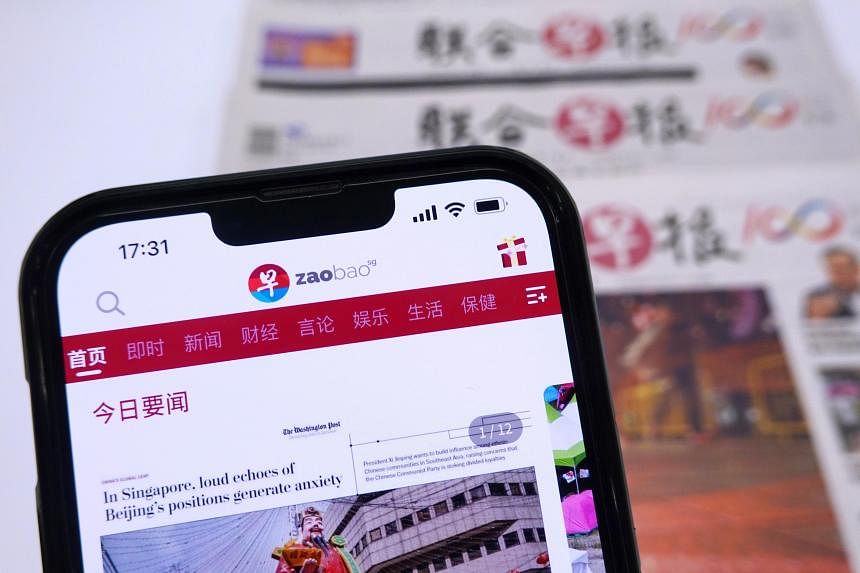
Lianhe Zaobao rejected the Washington Post's claims that it routinely echoed Beijing's "falsehoods", and prioritised its access to China. ST PHOTO: STEPHANIE YEOW

Magdalene Fung
Deputy Foreign Editor
August 5, 2023
The Singapore Government has issued a strong rebuttal to a report by The Washington Post alleging that Chinese-language media Lianhe Zaobao is pushing China’s propaganda and falsehoods.
Singapore Ambassador to the United States, Mr Lui Tuck Yew, said the Post’s July 24 article titled “In Singapore, loud echoes of Beijing’s positions generate anxiety” wrongly suggests that Zaobao echoes Beijing’s propaganda.
“Singapore’s mainstream media, including Lianhe Zaobao, reflect our distinct societal concerns, cultural history and perspectives. They report local and global news for Singaporeans and play a crucial role in preserving the voices of our multicultural communities,” Mr Lui wrote in a July 26 letter addressed to the Post’s editor, after the article ran.
The letter was posted on Saturday on the website of Singapore’s US embassy in Washington.
Mr Lui said that in his former role as Singapore Ambassador to China, he often heard Zaobao’s readers of various nationalities affirm the paper’s balanced coverage and uniquely Singaporean viewpoints.
“I’m therefore not surprised that Lianhe Zaobao has categorically rejected how it was wrongly portrayed in the article and clearly explained its editorial stance,” he said.
The Ambassador said it bears repeating that Singapore conducts its foreign policy based on the country’s own interests – a position that enjoys strong public support.
“We do not pick sides but uphold consistent principles,” he said.
“It is misguided for American news outlets to expect Zaobao to resemble the Washington Post, or for Singapore to follow either the United States or China. Our media and society are unique, and offer valuable perspectives that contribute to the global dialogue,” Mr Lui said.
The Washington Post article posits that Beijing is using ethnic Chinese communities abroad as a tool to achieve its geopolitical ambitions.
In particular, it accuses Zaobao of routinely echoing “some of Beijing’s most strident falsehoods, including denying evidence of rights abuses in Xinjiang”, and of prioritising its continued “access (to mainland Chinese readers) over critical coverage (of China)”.
In a statement provided to the Post prior to the article’s publication, the Ministry of Communications and Information (MCI) said its data “suggests Singapore’s media provide a balanced perspective that is trusted by Singaporeans”.
Polling done by MCI has also consistently shown that Singaporeans understand the need for an independent foreign policy, it said.
The ministry noted a July 2022 poll that showed 86 per cent of Singaporeans felt the Government should always act in Singapore’s best interest and not take sides between the US and China. Only 4 per cent felt Singapore should lean towards China, and another 4 per cent felt the Republic should lean towards the US.
“Polling conducted since 2018 has consistently found a significant majority comfortable with the state of our relations with both the US and China,” MCI said in the statement.
The proportion satisfied with Singapore’s ties with China ranged from 49 per cent in 2018 to 58 per cent now, while those satisfied with Singapore’s ties with the US ranged from 61 per cent in 2018 to 69 per cent currently.
The Post had partially cited MCI’s statement at the end of its report, but has not responded to the Ministry of Foreign Affairs’ requests to publish Ambassador Lui’s letter.
The Post’s report, by Singapore-based correspondent Shibani Mahtani and photographer Amrita Chandradas, argues that Beijing is influencing the sentiments of ethnic Chinese communities beyond its shores, particularly in South-east Asia, using them as an instrument towards realising its geopolitical ambitions.
The article also singled out Zaobao for echoing Beijing’s allegations that protests in Hong Kong and in mainland China were instigated by “foreign forces”.
The report said its conclusions were derived after examining more than 700 Zaobao articles through 2022 and early 2023.
A day after the Post published its report, Zaobao on July 25 put up on its website a comprehensive response – in Chinese and English – that it had earlier provided to the Post addressing the questions raised in the US daily’s article.
Zaobao editor Goh Sin Teck said in a short accompanying statement that the responses “were not adequately reflected” in the Post’s reporting.
“The Washington Post has selectively left out some facts while intentionally highlighting and putting together some information, and citing anonymous former and current journalists to paint a negative image of Lianhe Zaobao, which is regrettable but not surprising to us,” he said.
“Amid the current international geopolitical situation, the idea that ‘if you are not with us, you are against us’ is spreading.
“Now more than ever, Lianhe Zaobao believes that we should not be pressured by anyone into changing our editorial direction. We remain committed to staying objective; we will not be pressured by any party, and do not wish to be embroiled in China-US rivalry.”
Georgie boy is living example of karma.
Whole family Kena cancer
Illgotten gains all go towards medical fees
Whole family Kena cancer
Illgotten gains all go towards medical fees
Yeah lah... throw smoke and wait for response is one of 孙子兵法三十六计....For this sort of analysis you have to ask Bilahari he is the best smoke thrower around. George Yeo is a novice in comparison.
It started with the military war games competition and US Army does not like to be seem as loser... year after year.... US must be winners with most gold medal awards.... in any games they take part in...Speaking of ménage à trois the NZ family court is now trying to sort out how to portion property and other assets when this sort of arrangement comes to an acrimonious end. There is nothing in the statues to guide the judge.
US cannot be expose as loser in war games competition, it will expose the weakness of their military industrial complex as a bad arms designers and makers.... and they killed the games with bioweapon Covid19.
HK riot was a scapegoats to distract the world... The military war games competition involved 60 country powerful armed force competitors taking part.... military war games competition was a punch below the belt of US armed force weaknesses....
Last edited:
Singapore identity strong enough to withstand foreign pressures: Vivian Balakrishnan
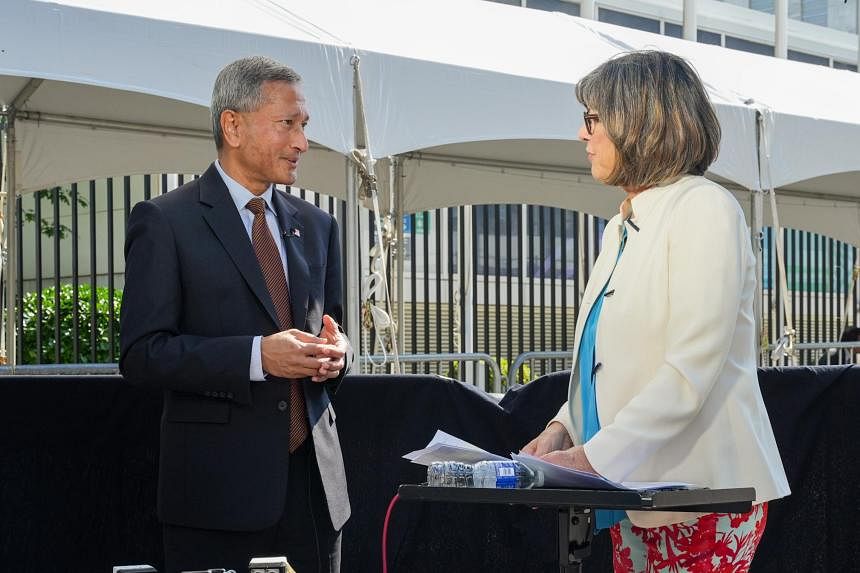
Foreign Minister Vivian Balakrishnan during an interview with CNN anchor Christiane Amanpour in New York on Sept 20. PHOTO: MFA

Bhagyashree Garekar
SEP 21, 2023
WASHINGTON – Singapore is taking appropriate precautions against the possibility of foreign influence operations within its society, but its strong sense of identity will be a bulwark against such pressures, Foreign Minister Vivian Balakrishnan said on Wednesday.
He was responding to a question from CNN International anchor Christiane Amanpour on how seriously the Singapore Government takes reports that China is trying to influence ethnic Chinese populations across South-east Asia, including in Singapore.
“It is something which we need to be aware of. It is something which we take appropriate precautions on,” he said.
“But my fundamental point is this – I trust Singaporeans.
“We know our identity and, most importantly, we understand what our long-term national interests are. It is not to be anybody’s vassal state or proxy.”
He said Singapore negotiates a path between the US and China, and is unapologetic about pursuing its own national interests.
“The way we navigate this nexus between the United States and China is to be straight with both of them. We tell them we have our own long-term national interests,” he said.
“Both of you are critical to our long-term national interests,” said the minister, referring to the US and China. “I do not have the luxury of saying sweet nothings in Beijing and sweet nothings in Washington. We play a constructive, honest broker role.”
The Singapore identity transcends ethnic or linguistic identities, Dr Balakrishnan noted.
“Singapore is a young city state, multiracial, multilingual. We are not Chinese, we are not Indians, we are not Malays, we are certainly not Americans,” he said.
“I am confident that there is a very strong sense of a Singapore identity. We may speak different languages, have different colours. But if you come to Singapore... you will realise there is a strong sense of identity.”
Also, the fact that Singaporeans can speak different languages and connect well with people in other countries is an asset, he added.
“Cultural pride, linguistic proficiency, being able to understand, and to appreciate, opportunities, both in the West and East, in India and in Europe, is a strategic advantage for us.
“The fact that we understand, and therefore, some people may think they have opportunities to influence us, that is baked into our cultural DNA,” he said.
Asked how Singapore negotiated as the US and China competed for influence in the Asia-Pacific, Dr Balakrishnan said the city-state is well intertwined with both.
“We have got great relations with the United States and with China. It is not just a form of words. The United States is the biggest foreign investor in Singapore, (and) also the biggest service trading partner in Singapore.
“China is our biggest trading partner for goods. We are a significant investor in China; we have also investments in the United States.
“For us, the best possible world is one in which the two big boys get along.”
Singapore’s sense is that neither the US nor China is raring for a fight. But their mutual distrust is a problem.
“Let me just say, for someone who has been there, interacted with them – neither side is actually spoiling for war,” said Dr Balakrishnan, adding that the fundamental problem is the lack of strategic trust.
“What that means is both sides have to assume the worst of each other,” he said. “They have got to take precautions, and that precaution is viewed as a potential threat, and... (they) take a counter precaution.”
The antidote to an escalatory spiral that could develop is talk.
“Our recommendation is there needs to be a lot more direct face-to-face interaction. There is no substitute (for) eyeball to eyeball, handshake to handshake, and having honest-to-goodness conversations.”
A real strategic conversation could begin during the Asia-Pacific Economic Cooperation (Apec) leaders’ summit in San Francisco in November, said the minister.
Unlike the Cold War era when the US and Soviet Union had a measure of each other, Washington and Beijing are still sussing each other out, he noted.
“Today, because the situation is still evolving so rapidly, neither side has really sized each other up and said ‘look, guys, we better put some guardrails, and not guardrails in a negative, aggressive sense, but guardrails around both of us, so we do not lose the plot’,” he said.
The Apec meeting could provide a platform for a dialogue essential to tackling the world’s mounting challenges.
“Now more than ever before, we need global leadership. The problems are beyond that of just the United States or China or Europe. In fact, you need the whole world together,” he said.
Tougher to articulate Singapore’s national interests amid US-China rivalry: New S R Nathan Fellow
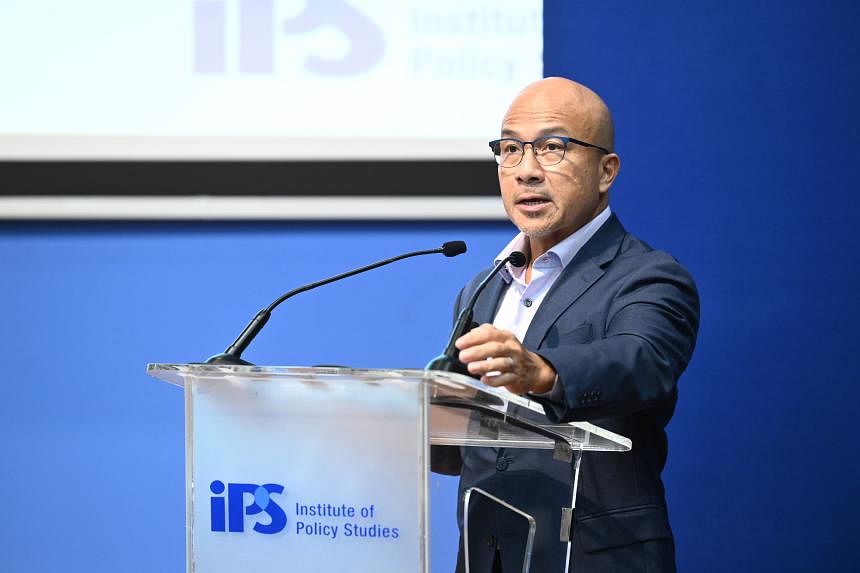
Prof Liow said that Singapore will find itself increasingly squeezed between the US and China, and will need to prepare for this growing pressure. PHOTO: INSTITUTE OF POLICY STUDIES/FLICKR
Joyce Lim
Correspondent
Oct 11, 2023
SINGAPORE - It has become more challenging for Singapore leaders to articulate the country’s foreign policy interests – and for society to understand them – against the backdrop of sharpening geopolitical rivalry, said international affairs scholar Joseph Liow on Tuesday.
It is right for Singapore not to choose sides between the United States and China, and to choose only its national interests, he said. But what exactly these interests are in relation to the major powers is no longer as evident as before, and Singapore policymakers cannot let up on efforts to explain the issues to the public, Prof Liow said.
The dean of Nanyang Technological University’s College of Humanities, Arts and Social Sciences was speaking at the Institute of Policy Studies’ (IPS) 13th IPS-Nathan Lecture Series, on Navigating Uncertainty: Our Region in an Age of Flux.
It was the first lecture in a three-part series examining the challenges and dynamics that shape South-east Asia, and the strategies that Singapore can take in a rapidly changing global environment.
Prof Liow is the 13th person appointed by IPS as its S R Nathan Fellow for the Study of Singapore.
“The US and China are locked in intense strategic competition that grows sharper by the day,” he said. Navigating this great power competition is the foremost foreign policy challenge today, he added.
Five paradigms can help observers understand the dynamics behind US-China relations and their trajectory going forward, he said.
The first is China’s rise, which challenges the status quo and the US’ hitherto dominance – what scholars of international relations call the “power transition theory”.
A second factor is a cycle of heightened insecurities, rooted in certain perceptions or misperceptions of each other’s intentions.
“China’s assertiveness has made smaller regional states feel less secure, resulting in their efforts to strengthen ties with the US. This has in turn made China feel less secure as Beijing accuses the US of trying to contain it. We also see something of this dynamic in the Taiwan Strait,” Prof Liow added, referring to how the island has come under increasing military and political pressure from Beijing.
The other three paradigms shaping US-China dynamics are ideology and nationalism, domestic politics, and personality-driven policies. President Joe Biden has cast the US-China rivalry as “democracy versus autocracy”, while China under President Xi Jinping is trying to “restore the ideological foundation of the country”, he said.
Against this backdrop of great power rivalry, Prof Liow said that Singapore will find itself increasingly squeezed between the US and China, and will need to prepare for this growing pressure.
Singapore will need to maintain good relations with both powers, and strengthen its value proposition. It will also need to be sensitive to increased scrutiny by the US and China of its choices, and stay ahead of the geopolitical curve by being a pathfinder of new domains in the future economy and security environment, he said.
Prof Liow added that even as Singapore will not choose sides but will choose only its national interests, “the devil is in the detail” of “what... our national interests are as they relate to foreign policy towards these two great powers”.
He said that in Singapore’s early years post-independence, foreign policy interests were clearly articulated by its leaders and accepted by the vast majority of the population, mostly without question. However, the situation has become “more complex” today, he said.
Citing Singapore’s position on Russia’s invasion of Ukraine as an example, Prof Liow said that “the Government has spared no effort in making its position very clear and has gone to great lengths to explain it”.
“Yet I know there are still a considerable number of Singaporeans who are not entirely convinced, and who persist in – if not, insist on – viewing our position on the Russia-Ukraine war through US-China lenses even though our opposition to the invasion has nothing to do with our relationship with Washington or Beijing.”
Singapore has strongly condemned Russia’s attack on Ukraine. It imposed sanctions on Russia, targeting several banks and goods like electronics, computers and military items.
Adding to the complexity is the presence of “narratives emanating from some external powers that are designed to appeal to diasporic communities”.
Against this backdrop, “our leaders and policymakers (need) to explain, educate, explain, educate, and then explain some more, why our foreign policy imperatives and priorities are what they are. There can be no letting up on this effort, because it can no longer be assumed that the logic behind what our national interests are as they relate to foreign policy is self-evident,” said Prof Liow.
During the question-and-answer session, moderated by Associate Professor Simon Tay, chairman of the Singapore Institute of International Affairs, Prof Liow was asked to comment on the implications of the conflict between Israel and Hamas for the US’ foreign policy outlook and US-China rivalry.
“This conflict initiated by Hamas is taking place at a very critical time. We were looking at some sort of reconfiguration of dynamics in the Middle East,” said Prof Liow. The Abraham Accords, signed in September 2020, normalised relations between Israel and several Arab states, and China also brokered an agreement for the resumption of diplomatic relations between Saudi Arabia and Iran.
He added that the conflict raised questions about whether there would be a reconfiguration of these shifting dynamics, and would compel to some degree a reconfiguration of American engagement and deployment of resources towards Israel, an ally.
“I think that the Americans have realised that they have, for want of a better phrase, dropped the ball a bit on the Middle East. They took a step back, they shifted their focus to the Indo-Pacific, China, and then this thing blows up.”
“Israel, an old ally, old friend, coming back into the picture requiring that support -- that will complicate things even further,” said Prof Liow. The US, already facing the fatigue of being a global power, would be really stretched, he added.
Similar threads
- Replies
- 11
- Views
- 641
- Replies
- 12
- Views
- 951
- Replies
- 0
- Views
- 368
- Replies
- 11
- Views
- 514

